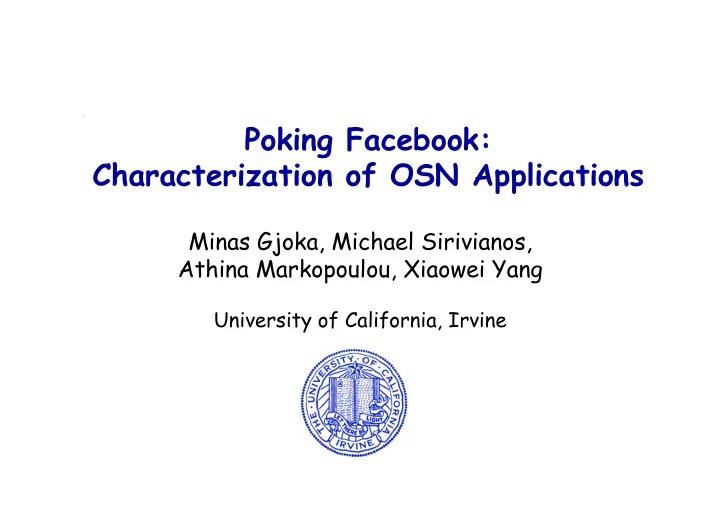

Poking Facebook: Characterization of OSN Applications Minas Gjoka, Michael Sirivianos, Athina Markopoulou, Xiaowei Yang University of California, Irvine
Outline • Motivation and contributions • Datasets description • Data analysis • User Coverage • Conclusion
Motivation • Very popular online social networks – Facebook – 70 million users – overall estimated 270 million users in all OSNs • In May 2007, Facebook opened their platform to third-party developers for online applications – in mid-February 2008, 866M installations of 16.7K distinct Facebook applications, 200K developers • Application popularity and adoption dynamics – engineering and marketing reasons
Contributions • First study of applications popularity and user reach in online social networks – Aggregate Application Popularity. – Popularity of Individual Applications. • Simple and intuitive method – simulates the application installation process – captures user coverage from the popularity of applications
Outline • Motivation and contributions • Datasets description • Data analysis • User Coverage • Conclusion
Data sets • Data Set I, crawled from Adonomics – (day, application, #installations, #daily active users) – 170-day period until mid-February. • Data Set II, crawled directly from Facebook – a subset of Facebook user profiles (300K) – (user ID, list of installed applications) • Crawling/analysis scripts publicly available: – http://www.ics.uci.edu/~mgjoka/facebook
Outline • Motivation and contributions • Datasets description • Data analysis – Aggregate Facebook application statistics – Popularity of individual applications – Application categories • User Coverage • Conclusion
Facebook Applications Aggregate Installation and Usage Weekly usage pattern Average user activity decreases
Application Popularity Individual Applications: Daily Active Users • Highly skewed distribution • Not a power law • Pick top-5 applications daily: only 17 unique apps in the 170-day period
Application Popularity The effect of application category
Outline • Motivation and contributions • Datasets description • Data analysis • User Coverage – Model – Validation Simulations • Conclusion
Number of applications per user Dataset II
Users and Applications • Popularity of applications is publicly available. • Unknown how applications distributed among users • Example of usefulness: advertising …… user n user 1 user 2 user 3 n(users) on the order of millions m(unique apps) on the order of thousands total installations on the order of hundreds of millions
Users-Applications Model (1) 3 inst. 4 inst. 1 inst 2 inst 2 inst Applications 1 2 3 .. .. m Users ... ... 1 2 3 i n
Users-Applications Model (2) • Simulate a preferential installation process based on a balls and bins model: Applications 1 2 3 .. .. m Users ... ... 1 2 3 i n
Users-Applications Fitting • We use the crawled dataset to fit the parameters of the model • Clearly not uniform • Good fit with ρ =1.6 and init=5
User Coverage Simulation vs. Real Data (1) Application Popul #Installations Coverage Coverage Name Rank Real(%) Simulation(%) Flixster 5 87609 30.2 30.2 Graffiti 15 45396 41.6 39.8 cumulatively Flirtable 46 19504 43.9 42.6 Hug Me 99 9685 44.9 43.6 Nicknames 12 50825 51.5 51.1 73.5% Total=213019 One instance of five apps randomly selected
User Coverage Simulation vs. Real Data (2) • User coverage for all applications cumulatively (taken in decreasing order of popularity) • Simulation with fitted parameters agrees with crawled dataset
Conclusion • A first study of FB application usage. – average user activity decreases – application installation process model • Future extensions – study dynamic aspects, such as application virality. – further analysis through the balls and bins model
Questions?
Recommend
More recommend